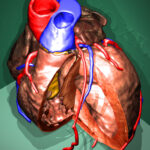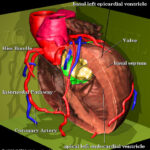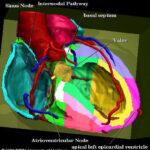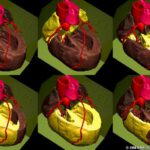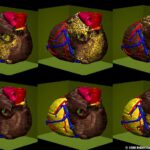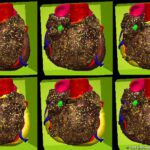Based on the Visible Human Female, we developed a high-resolution 3D model of the human heart. The model can be used to simulate the excitation patterns of the beating heart.
The heartbeat is driven by the cardiac excitation cycle. It consists of an electrical wave that propagates through the myocardial tissue, which can be observed using electrocardiography (ECG). To simulate the excitation cycle, the anatomical 3D heart model was extended by a 3D cellular automaton. Using a volume editor, the sinus node, the atrioventricular node, and the excitation conduction system were added to the model.
The model shows the physiological (normal) behaviour of the beating heart (left, excited areas in yellow). The excitation is generated in the sinus node and propagates over the atria and the AV node to the ventricles. Eventually, the ventricles recover and the excitation subsides.
When the parameters of the model are varied according to changes in real ischemic myocardial tissue (heart attack), excitation patterns appear that resemble certain cardiac arrhythmias.
For example, a change in the excitability threshold leads to patterns corresponding to atrial flutter and atrial fibrillation. In case of atrial flutter (center), a circling macro-reentry is seen, while the ventricular excitation pattern remains unchanged. In atrial fibrillation (right), a directional excitation conduction can no longer be observed.
For images of the heart inside the thorax, have a look at the torso and internal organs.
References
- Jan Freudenberg, Thomas Schiemann, Ulf Tiede, Karl Heinz Höhne: Simulation of cardiac excitation patterns in a three-dimensional anatomical heart atlas. Computers in Biology and Medicine 30 (4), 2000, 191-205.
- Thomas Schiemann, Jan Freudenberg, Bernhard Pflesser, Andreas Pommert, Kay Priesmeyer, Martin Riemer, Rainer Schubert, Ulf Tiede, Karl Heinz Höhne: Exploring the Visible Human using the VOXEL-MAN framework . Computerized Medical Imaging and Graphics 24 (3), 2000, 127-132.
Back to Visible Human Project
